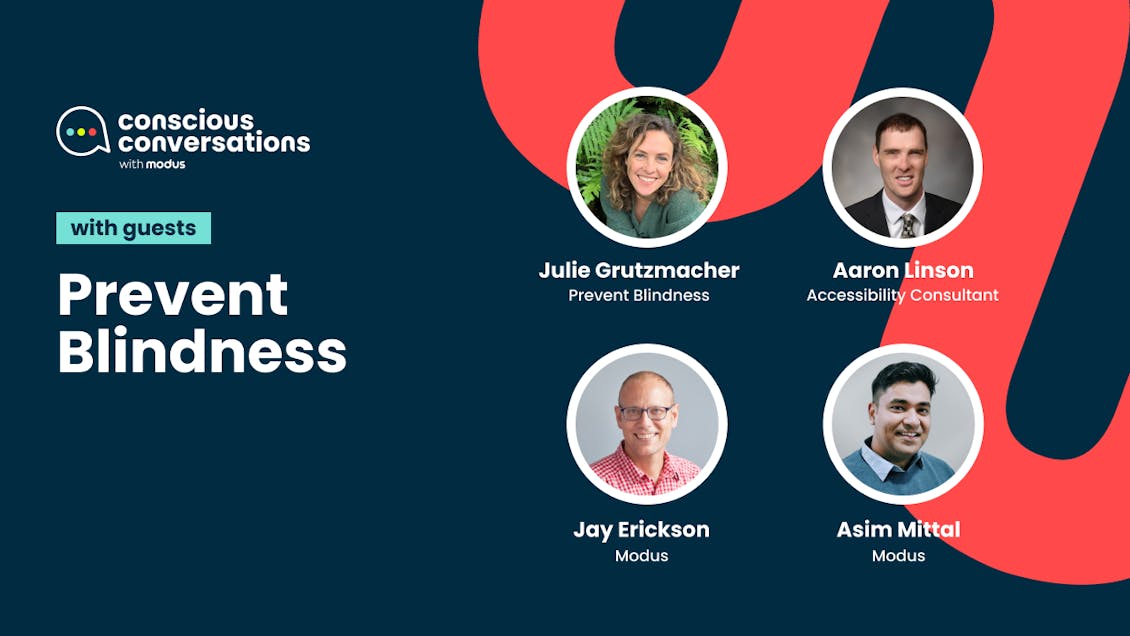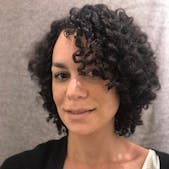Webinar recap: Digital Inclusion for the Visually Impaired

Improving digital accessibility authentically starts with understanding people’s needs.
Globally, more than 2 billion people are blind or visually impaired, according to the World Health Organization. And yet, according to a recent IDC report, fewer than 10% of websites are fully accessible. That means a significant portion of the population cannot fully access the web, causing frustration, isolation, and limited opportunities.
While technology such as AI has made great advancements in improving accessibility, building inclusive digital interfaces starts with understanding user’s needs. For digital creators to truly put themselves in the users’ mindsets, they need to hear from them firsthand.
In our latest episode of Conscious Conversations, a speaker series where we talk with some of today’s most inspiring waymakers on the power of inclusive leadership in marketing, design, innovation, and technology, we spoke with advocates from Prevent Blindness. The nation’s leading organization dedicated to fighting blindness and saving sight, Prevent Blindness has developed the ASPECT Program (Advocacy, Support, Perspective, Education, Communication, and Training) to empower the visually impaired to offer feedback on various initiatives, including digital accessibility.
Jay Erickson, Chief Innovation Officer and Healthcare Lead at Modus, sat down with Julie Grutzmacher, Director of Patient Advocacy and Population Health Initiatives, Prevent Blindness; Aaron Linson, Accessibility Consultant; and Asim Mittal, VP, Engineering, Modus, to discuss the digital inclusion landscape.
Read on and watch the full episode to hear about the impacts of poor digital accessibility, how AI tools are cause for both excitement and concern, and why a mindful approach is necessary to deliver accessibility in the digital design and development process.
Watch the episode to learn:
- How accessible experiences can impact customer satisfaction loyalty
- Where accessibility fits into the digital design and development process
- The promising role of tools and technology such as AI in advancing accessibility
- How disability advocates can be included in digital design and optimization
Geting started with digital accessibility
According to McKinsey, companies that lack accessible websites and digital experiences stand to lose out on $6.9 billion annually — a figure that is expected to grow as the aging population increases. As federal and state governments push for broader digital accessibility, how can your organization show up authentically for this audience?
Our panel shared actionable takeaways for teams that want to get started with inclusive design today:
Invite community stakeholders to the design process. It can be difficult for sighted individuals to fully understand the range of challenges faced by the visually impaired population. That’s why programs like ASPECT that bring the voice of the impacted users to the table are so impactful. Consider user interviews, product testing, and co-design workshops to help teams build empathy. Another great resource for teams that are just getting started is Microsoft’s Inclusive Design literature and videos.
Incorporate accessibility and usability standards into your digital design and development, ideally from the beginning. The Web Content Accessibility Guidelines (WCAG) were developed to help web designers and site owners meet best practice standards. According to the guidelines, web accessibility means that users can perceive, understand, navigate, and interact with the web, as well as contribute to it. At Modus, we also prioritize usability to ensure that experiences are intuitive, efficient, error-free, and easy to understand.
Taking into account accessibility and usability from the start of the design process can save time and money, as well as reduce the risk of legal issues and compliance concerns.
Take one step at a time. Of course, if you have a ways to go before meeting accessibility and usability standards, there’s no reason to delay action. Start with an accessibility audit from a digital partner like Modus to see where to prioritize quick fixes. From updated image descriptions so that screen readers can accurately share information to adding captions to your videos, there are small ways to make a big impact in closing the digital divide.
About Julie Grutzmacher:
Julie Grutzmacher, MSW, MPH grew up in Wisconsin and completed her undergraduate degree in Social Work in Minnesota. After college she joined the Peace Corps. Julie spent two years in Swaziland, Africa, where she lived and worked in a rural village providing HIV/AIDS education, mitigation, and community development services. It was during that experience that her interest in public health and health disparities was forged. After returning to the U.S., Julie completed her Masters in Social Work at the University of Illinois at Chicago, and later was employed as a social worker in the Neonatal Intensive Care Unit (NICU) at Rush Hospital. This experience cemented professional goals relating to the elimination of health disparities and improvement of outcomes for marginalized populations.
After the NICU, Julie pursued a second Masters Degree, this time in Public Health, while simultaneously working in population health management, providing care coordination and health education for high risk pregnant women in Chicago’s South Side. It was in this role that her passion for accessible and quality primary care was elucidated. She went on to co-create and manage a primary care leadership training program for multidisciplinary medical residents at the University of Chicago. Julie joined the Prevent Blindness team in May of 2020 as the Director of Patient Advocacy and Population Health Initiatives where she oversees the Center for Vision and Population Health (CVPH) and the ASPECT patient-engagement program. She is passionate about reducing all barriers to eye care.
About Aaron Linson:
Certified through the IAAP with his CPACC, Aaron is an advocate for all things digital. Aaron believes that accessibility not only intersects both digital and physical worlds, it also affects lives. One of Aaron’s main goals is to connect digital and physical realms through education and advocacy. When Aaron isn’t nerding out about accessibility, you can find him writing songs, hiking trails as an adult leader through Trail Life, or playing various instruments.
About Conscious Conversations:
Tune into Conscious Conversations with Modus to hear how leaders in fields such as technology, design, marketing, and innovation are making a positive, progressive impact on our collective culture. Get insights from their unique points of view and tangible takeaways to bring back to your organization.
Improving DEIA in the workplace and our communities is a process of asking questions, learning — and un-learning — to build mutual trust and understanding. At Modus, we ensure that the digital products we make are human-centered by including real people throughout the design process, and that includes making room for those who have been historically excluded. So let’s listen, learn, and lead the way together, toward real action and impact.
Have an idea for a guest for this series? Apply to be featured here.



